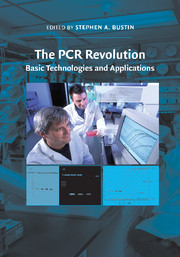Book contents
- Frontmatter
- Contents
- Contributors
- Foreword by Russell Higuchi
- Preface
- I BASIC TECHNOLOGIES
- II APPLICATIONS
- 10 Polymerase chain reaction–based methods for the detection of solid tumor cancer cells for clinical diagnostic and prognostic assays
- 11 Polymerase chain reaction and infectious diseases
- 12 Polymerase chain reaction and respiratory viruses
- 13 Polymerase chain reaction and severe acute respiratory syndrome
- 14 The MMR vaccine, measles virus, and autism – A cautionary tale
- 15 Noninvasive prenatal diagnosis using cell-free fetal nucleic acids in maternal plasma
- 16 Polymerase chain reaction–based analyses of nucleic acids from archival material
- 17 Microarrays and quantitative real-time reverse transcriptase–polymerase chain reaction
- 18 Polymerase chain reaction in the detection of genetic variation
- 19 Polymerase chain reaction: A blessing and a curse for ancient deoxyribonucleic acid research
- Index
- Plate section
- References
13 - Polymerase chain reaction and severe acute respiratory syndrome
Published online by Cambridge University Press: 25 January 2011
- Frontmatter
- Contents
- Contributors
- Foreword by Russell Higuchi
- Preface
- I BASIC TECHNOLOGIES
- II APPLICATIONS
- 10 Polymerase chain reaction–based methods for the detection of solid tumor cancer cells for clinical diagnostic and prognostic assays
- 11 Polymerase chain reaction and infectious diseases
- 12 Polymerase chain reaction and respiratory viruses
- 13 Polymerase chain reaction and severe acute respiratory syndrome
- 14 The MMR vaccine, measles virus, and autism – A cautionary tale
- 15 Noninvasive prenatal diagnosis using cell-free fetal nucleic acids in maternal plasma
- 16 Polymerase chain reaction–based analyses of nucleic acids from archival material
- 17 Microarrays and quantitative real-time reverse transcriptase–polymerase chain reaction
- 18 Polymerase chain reaction in the detection of genetic variation
- 19 Polymerase chain reaction: A blessing and a curse for ancient deoxyribonucleic acid research
- Index
- Plate section
- References
Summary
Severe acute respiratory syndrome (SARS) first emerged in Guangdong Province, China, in November 2002, and presented as an outbreak of a typical pneumonia that was soon recognized as a global threat. In Mainland China, it infected 5,327 people and caused 349 deaths within the first seven months of its recognition. In Hong Kong, SARS caused considerable disruption as this area faced the largest outbreak outside of Mainland China. It infected 1,755 people and caused 299 deaths (a fatality rate of 17.04%). Among the infected, 405 people (23.08%) were health care workers and medical students in hospitals and clinics. Within a month of recognition of this as a new type of infection, but before the disease pathogen was identified, it had spread to thirty-three countries and regions over the world, largely as a result of international air travel.
Although the number of worldwide cases remained relatively low (8,098 cases), the mortality rate (774 deaths) remained relatively high until July 7, 2003. This rate resulted in widespread concern, sometimes to the point of panic, in both affected and nonaffected populations. It was viewed in the same category as acquired immunodeficiency syndrome (AIDS) – a severe and readily transmissible new disease to emerge in the twenty-first century.
The SARS epidemic highlighted the need for a rapid international response to disease control. The recent outbreak of H5N1 influenza in birds in Southeast Asia has only reinforced the potential for a pandemic spread of newly emerging or evolving infectious agents.
- Type
- Chapter
- Information
- The PCR RevolutionBasic Technologies and Applications, pp. 212 - 228Publisher: Cambridge University PressPrint publication year: 2009



